capable of performing tasks that typically require human intelligence.12 This includes abilities like: Learning: AI systems can learn from data, identify patterns, and improve their performance over time without being explicitly programmed for every scenario.3 This is often achieved through techniques like machine learning and deep learning.4 Reasoning and Problem-Solving: AI can process information, make logical deductions, and strategize to solve problems, even in complex and unpredictable situations.5 Perception: AI enables machines to interpret sensory input, such as images (computer vision) and spoken language (speech recognition), allowing them to "see" and "hear" the world around them.6 Understanding and Generating Language: Natural Language Processing (NLP) is a branch of AI that deals with the interaction between computers and human language, allowing7 AI to understand, interpret, and generate text and speech.8 Decision-Making: AI systems can analyze vast amounts of data and make recommendations or decisions, often with greater speed and accuracy than humans.9 Creativity: Emerging forms of AI, like generative AI, can create original content such as text, images, video, and audio.10 In essence, AI aims to empower computers and machines to simulate human cognitive functions.11 It's an umbrella term encompassing various technologies and approaches.12 While the concept of "artificial general intelligence" (AGI), where machines possess human-like intelligence across all cognitive tasks, is still largely theoretical and a long-term goal, the AI we encounter today is primarily Narrow AI (or Weak AI).13 This type of AI excels at specific tasks, like: Voice assistants (Siri, Alexa)14 Recommendation systems (Netflix, Amazon)15 Fraud detection in finance16 Medical diagnosis17 Self-driving cars18 Image recognition AI is constantly evolving and has a profound impact on various industries and aspects of our daily lives, driving innovation and automation.19 AI can be categorized in a few different ways, often based on their capabilities or their functionality. Here's a breakdown of the most common types: Types of AI Based on Capabilities (Levels of Intelligence) This classification reflects the progression of AI from basic task execution to hypothetical human-level or even superhuman intelligence.
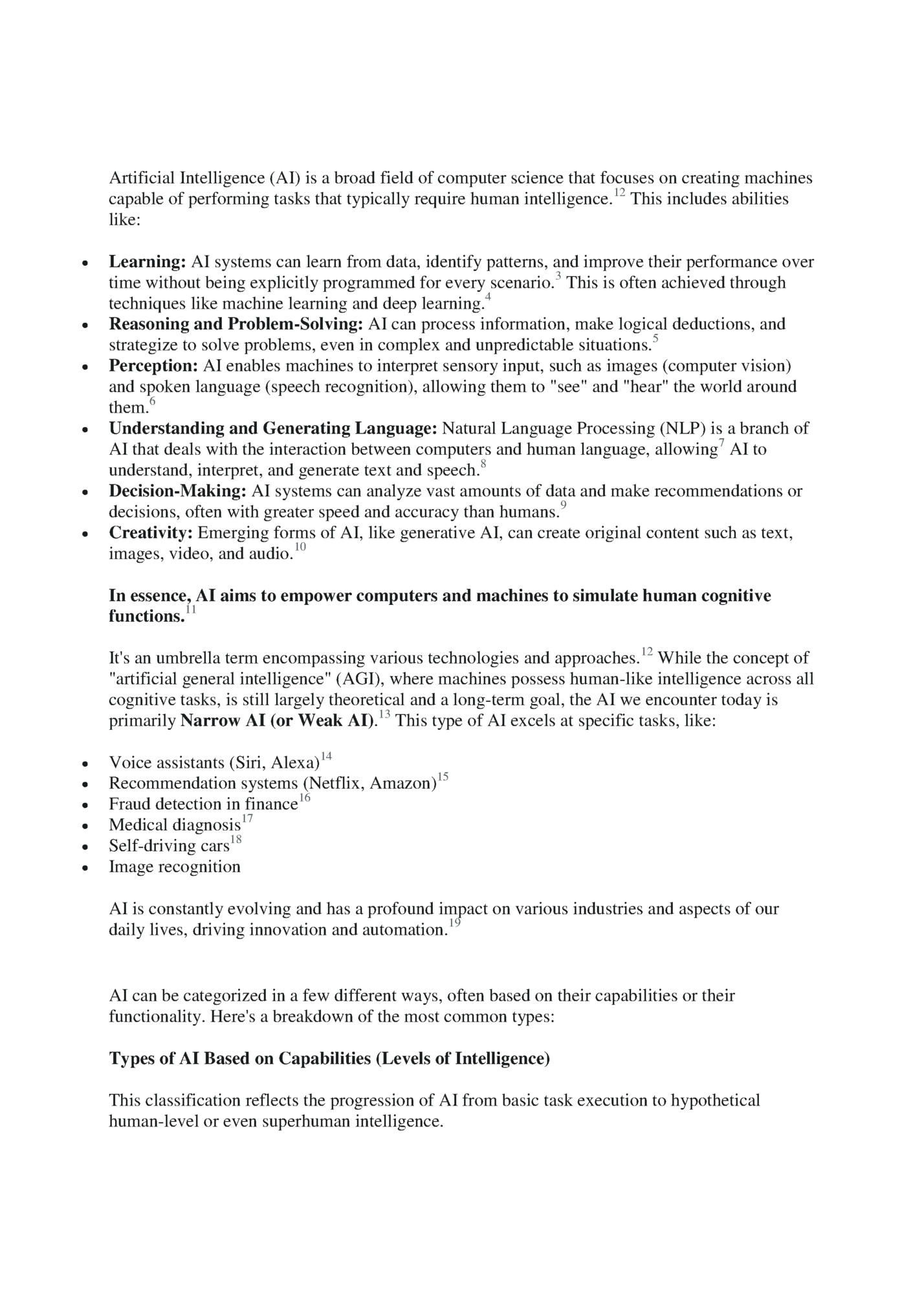
o Description: This is the only type of AI that currently exists. It's designed and trained for a specific, narrow task or set of tasks. It excels in its specialized domain but cannot operate outside of it. It doesn't possess genuine intelligence, consciousness, or self-awareness. o Characteristics: Task-specific. Operates within predefined constraints. No general cognitive abilities. o Examples: Virtual assistants (Siri, Alexa, Google Assistant), recommendation systems (Netflix, Amazon), facial recognition software, spam filters, chess-playing programs (like Deep Blue), most current chatbots (including large language models like ChatGPT are considered advanced Narrow AI). 2. General AI (Artificial General Intelligence - AGI / Strong AI): o Description: This is a theoretical type of AI that would possess cognitive abilities similar to a human. An AGI system could understand, learn, and apply its intelligence across a broad range of tasks, solving unfamiliar problems and adapting to new situations, much like a human. It would have human-like reasoning, learning, and problem-solving abilities. o Current Status: AGI is still largely in the realm of research and theory; it has not yet been achieved. o Examples: No true examples currently exist. 3. Super AI (Artificial Super Intelligence - ASI): o Description: This is a hypothetical future form of AI that would surpass human intelligence in all aspects, including creativity, general wisdom, problem-solving, and social interactions. It would not only mimic human intelligence but significantly exceed it. It's often associated with the concept of self-aware AI. o Current Status: Purely speculative and raises significant ethical and philosophical questions. o Examples: Exists only in science fiction. Types of AI Based on Functionality (How they Operate) This classification describes the operational capabilities and complexity of AI systems. 1. Reactive Machines: o Description: The most basic form of AI. These systems only react to specific inputs with predetermined outputs. They have no memory of past experiences and cannot "learn" or adapt over time. Each interaction is treated as a new one. o Characteristics: No memory or past experience. Task-specific. Lacks understanding of context. o Examples: IBM's Deep Blue (chess computer), simple spam filters, some basic factory robots. 2. Limited Memory AI:
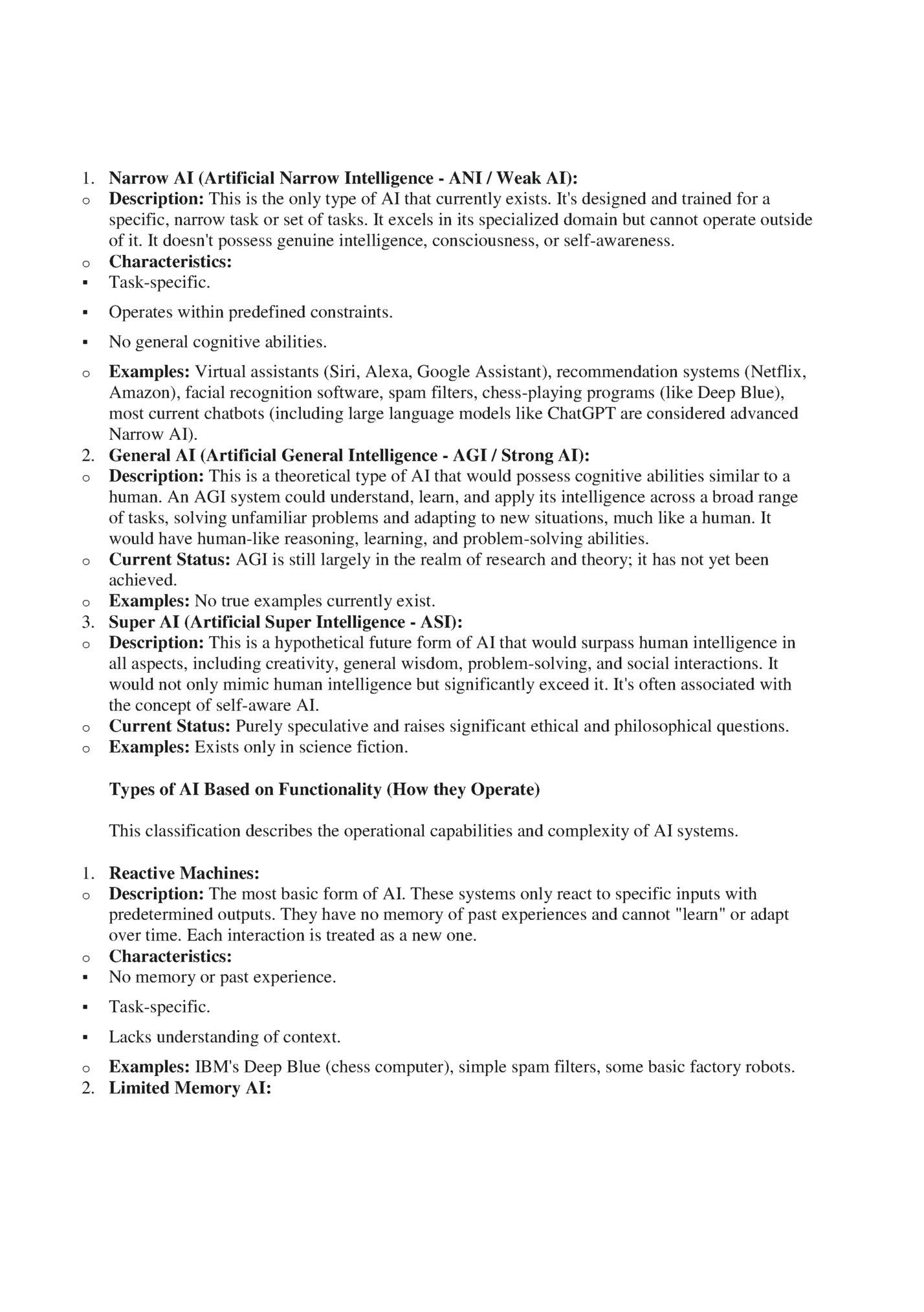
o Description: These AI systems can use past experiences or historical data to inform current decisions. They have a short-term or "limited" memory, allowing them to adapt their responses based on recent information. Most modern AI applications fall into this category. Characteristics: Can retain and use past data. Requires training on large datasets. Improved adaptability compared to reactive machines. o Examples: Self-driving cars (use recent sensor data to make decisions), chatbots (refer to past interactions in a conversation), recommendation engines (use Browse history), predictive maintenance systems. 3. Theory of Mind AI: o Description: This is a theoretical stage of AI that would be capable of understanding and interpreting human emotions, beliefs, intentions, and social interactions. It would be able to anticipate how humans might react and adjust its responses accordingly, leading to more personalized and effective interactions. o Current Status: Does not exist yet, but active research is ongoing. o Examples: Hypothetical advanced AI systems that can exhibit empathy or truly understand sarcasm. 4. Self-Aware AI: o Description: The most advanced and theoretical type of AI. Self-aware AI systems would possess consciousness, self-awareness, and the ability to form their own identity. They would understand their own existence and their place in the world, capable of autonomous decisionmaking based on a deep understanding of themselves and their environment. o Current Status: Purely conceptual and highly speculative. o Examples: Found only in science fiction. Other Important Distinctions: o o Symbolic AI vs. Connectionist AI: Symbolic AI (Good Old-Fashioned AI - GOFAI): Relies on explicit rules, logic, and symbols to represent knowledge and perform reasoning. It's a "top-down" approach, where human knowledge is encoded. Good for tasks with clear, well-defined rules (e.g., expert systems). Connectionist AI: Uses artificial neural networks (ANNs) to learn patterns from vast amounts of data, mimicking the brain's interconnected neurons. It's a "bottom-up" approach, learning associations. This is the foundation of most modern machine learning and deep learning advancements. Generative AI: A subset of AI (primarily Limited Memory AI) that focuses on creating new content, such as text, images, audio, or video, based on patterns learned from training data. Examples include ChatGPT, Midjourney, DALL-E. The field of AI is constantly evolving, with new capabilities and classifications emerging. However, these categories provide a solid framework for understanding the diverse landscape of artificial intelligence.
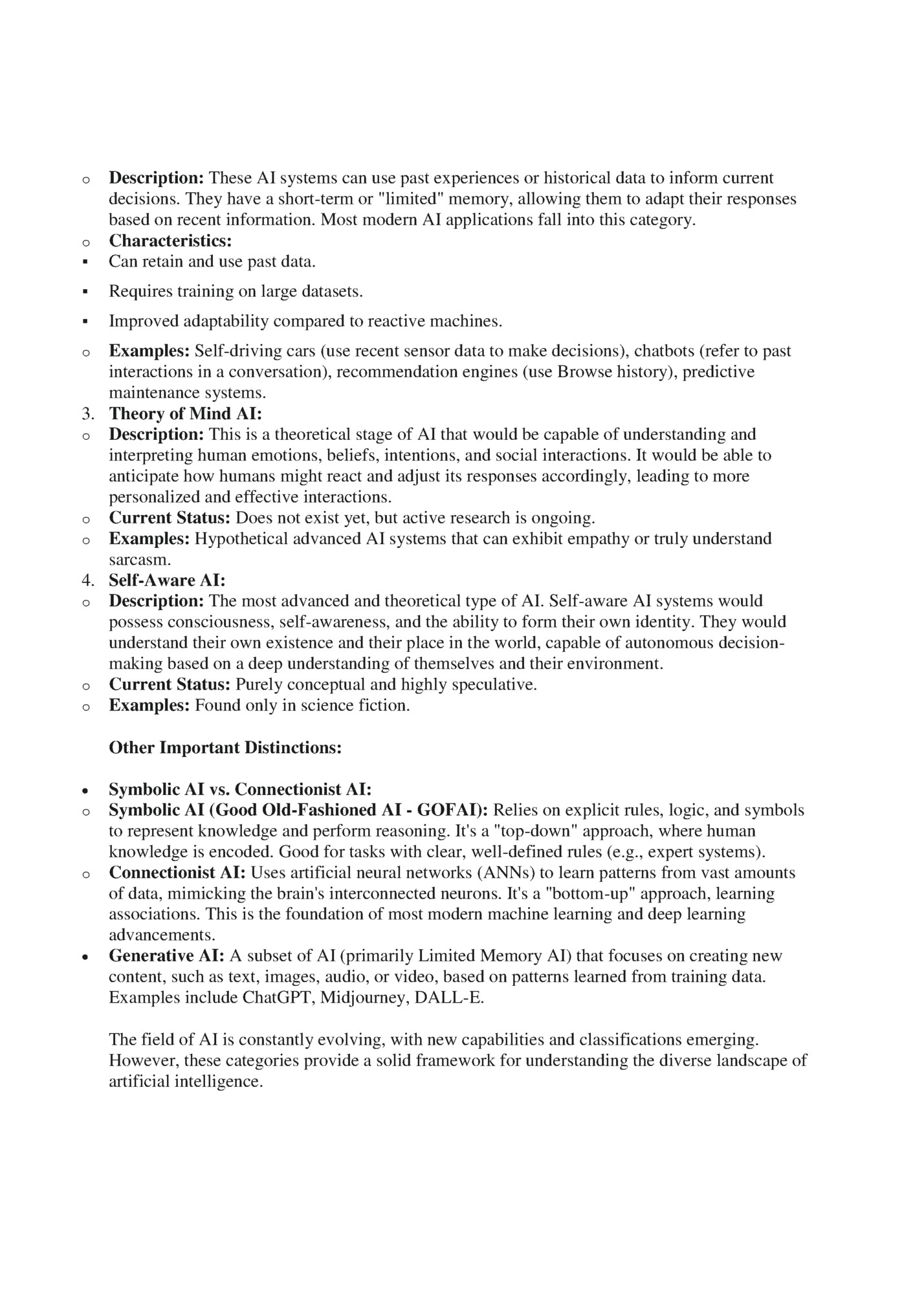
basic definition and types. Here's a breakdown of additional relevant information: AI in India: A Deeper Dive 1. Current Landscape and Key Trends (2024-2025): o o o o Generative AI is a major driver: Generative AI (Gen AI) is dominating the AI landscape in India. This includes: Localized AI Models: Gen AI is being tailored to India's diverse linguistic and cultural landscape, enabling AI solutions to process regional languages and address local market dynamics, especially in Tier-2 and Tier-3 cities. Multi-Modal AI Applications: Businesses are increasingly using multi-modal Gen AI (integrating text, audio, video) to create seamless and personalized user experiences. Transforming Software Development: Gen AI is automating tasks like code generation, testing, and debugging, boosting productivity and reducing development costs. Democratization of AI: Low-code/no-code platforms are making AI accessible to a wider audience, including less digitally savvy users, fostering inclusivity. Startup Ecosystem Boom: India's vibrant startup ecosystem is heavily adopting Gen AI. Startups leveraging AI for scalability and efficiency are leading innovation, particularly in ecommerce, fintech, and healthcare. Data as the Cornerstone: The power of Gen AI is intrinsically linked to data. India's data analytics market is growing rapidly, emphasizing the need for robust data management practices. Talent Hub: India is rapidly becoming a global AI talent hub, with a significant increase in AIskilled professionals. The demand for AI professionals is projected to reach 1 million by 2026. Strategic Investments: The Indian government, through the IndiaAI Mission (approved in 2024 with ₹10,300 crore over five years), is making substantial investments in AI infrastructure, including high-end common computing facilities with powerful GPUs. Businesses are also prioritizing AI investments, with many planning significant increases in tech spending. AI Integration with Digital Public Infrastructure (DPI): India's robust DPI (like UPI, Aadhaar) provides a strong foundation for scaling AI applications across various sectors, bridging traditional adoption barriers. Examples include NPCI's Hello! UPI for regional language interaction and IRCTC's AskDisha chatbot. Responsible AI Focus: As AI adoption grows, there's a strong focus on creating robust regulatory frameworks to ensure ethical and responsible use, addressing data privacy, algorithmic transparency, and bias mitigation. Human-AI Collaboration: The trend is towards AI supporting rather than replacing humans, leading to new, often more valuable and interesting, jobs. Upskilling and reskilling the workforce are crucial. 2. Future Outlook (Next 5 Years in India): Accelerated Pace of Life: AI will significantly speed up daily interactions with businesses, governments, and service providers, handling routine tasks and allowing humans to focus on complex cases.
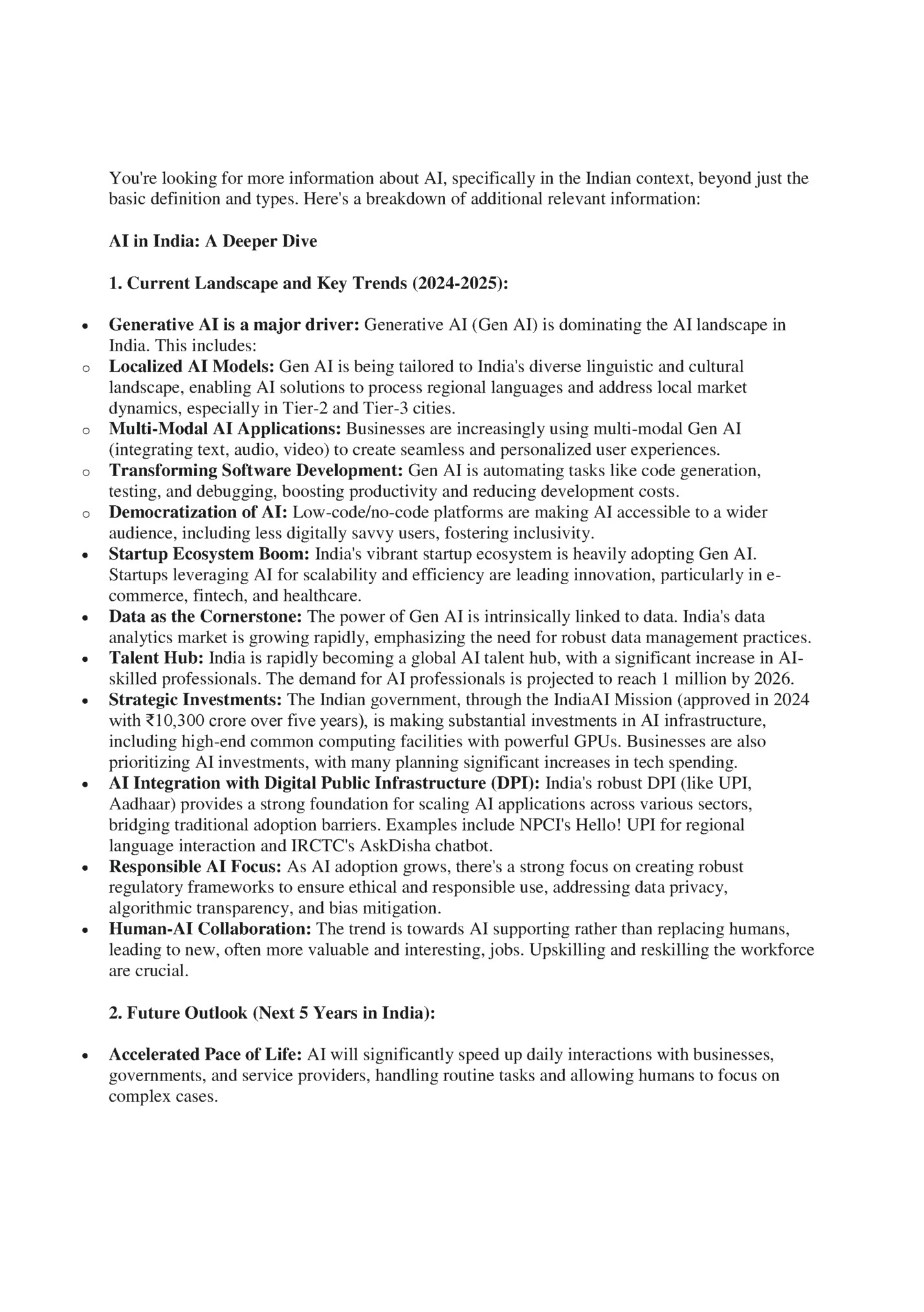
o o o o o o Efficiency Overdrive in Business: AI will be ubiquitous, used for product design, consumer behavior prediction, supply chain monitoring, and even hiring. Job Disruption and Creation: While some jobs will be disrupted by automation, new, more valuable jobs requiring AI-related skills will be created. The emphasis will be on flexible and cognitively agile skills. Personalized Experiences: AI will drive personalization across various sectors, from tailored educational lessons to customized medical treatments and financial advice. Revolution in Key Sectors: Healthcare: Faster, more accurate diagnoses, personalized medicine, early disease detection, and enhanced telemedicine. Agriculture: Precision farming, weather forecasting, real-time crop pricing, and improved supply chain efficiency. Finance: Fraud detection, advanced risk modeling, personalized financial advice, and streamlined operations. Education: AI tutors, personalized learning paths, and teachers as facilitators. Manufacturing: Optimized operations, improved quality control, and streamlined supply chains. Transportation: Autonomous vehicles and optimized logistics. Quantum AI: The integration of quantum computing into AI is expected to revolutionize machine learning, enabling more efficient processing of enormous datasets for complex problems in STEM, logistics, and finance. AI-Driven Cybersecurity: AI will become indispensable for threat detection and prevention, reducing costs and enhancing security. Edge Computing and IoT: The explosion of data from IoT devices and 5G will drive the adoption of edge computing to process data locally, reducing latency and enabling real-time decision-making for smart cities and industries. 3. Ethical Considerations of AI in India: Bias and Discrimination: A primary concern is ensuring AI systems are fair and do not perpetuate or amplify existing societal biases. This requires diverse and inclusive training data and careful algorithmic design. Transparency and Explainability: The "black box" nature of some AI systems raises concerns. Efforts are needed to make AI decisions understandable, especially in high-stakes applications like healthcare and finance. Privacy and Data Security: AI's reliance on vast amounts of data necessitates robust data protection policies and encryption methods to safeguard personal information and ensure informed consent. Accountability and Responsibility: As AI becomes more autonomous, establishing clear lines of responsibility for AI actions and errors is crucial. This involves defining liability frameworks and ensuring human oversight. Job Displacement: The potential for AI to automate tasks and displace jobs is a significant concern. Reskilling and upskilling programs are vital to mitigate this risk and prepare the workforce for AI-driven roles. Digital Divide: Ensuring equitable access to AI technologies and the benefits they offer, especially in rural and underserved areas, is a key ethical challenge.
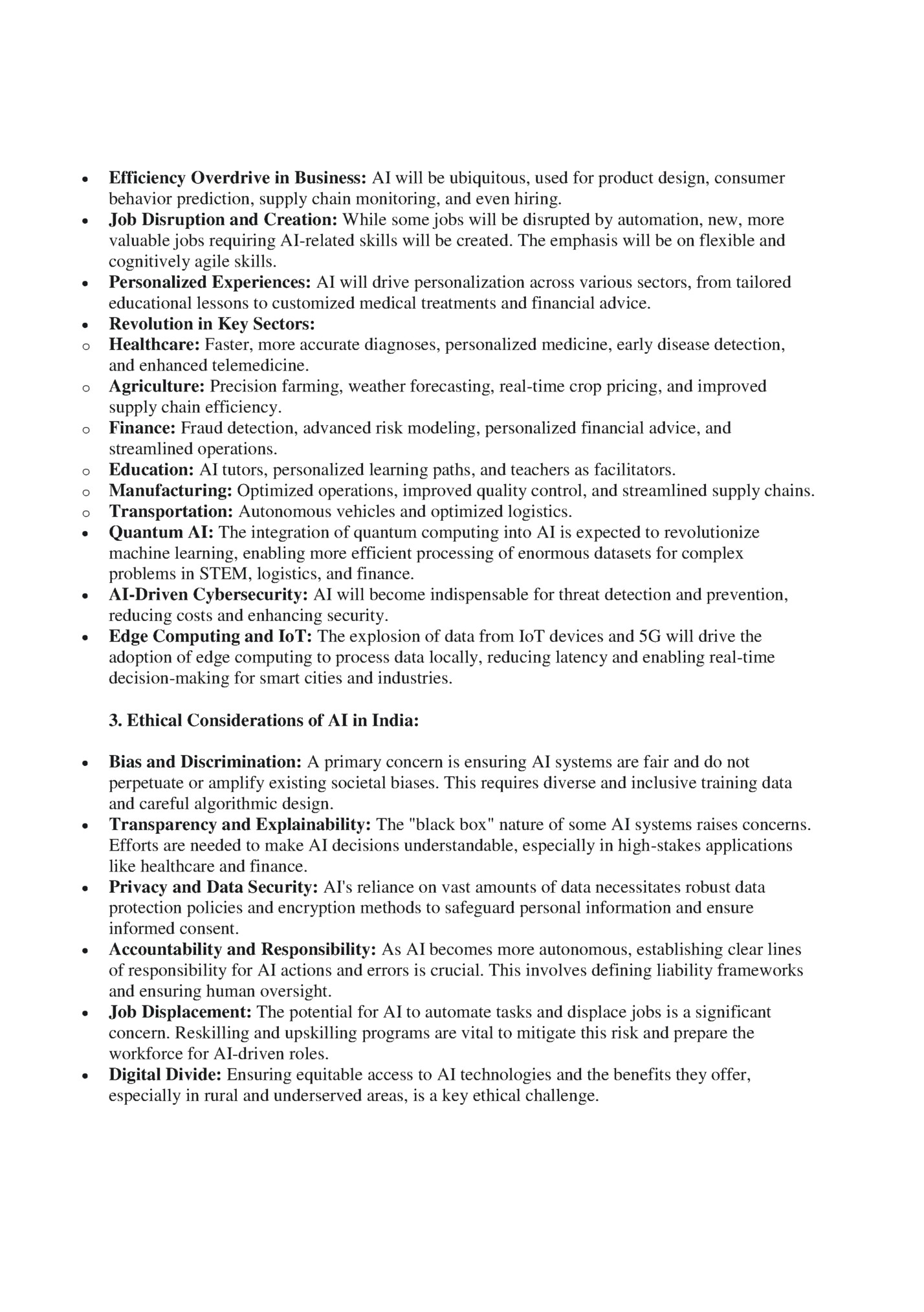
Misinformation and Deepfakes: The rise of generative AI tools makes it easier to create convincing but fake content, posing challenges for societal trust and integrity. 4. AI Policy and Regulations in India: o o o o o Evolving Landscape: India's AI regulatory framework is still evolving. Currently, there isn't one single, dedicated law exclusively governing AI. Instead, it relies on a combination of existing laws, policies, and sector-specific guidelines. "Pro-Innovation" Approach: India aims for a "pro-innovation" approach, balancing the fostering of AI innovation with addressing potential risks and ethical concerns. Key Policy Drivers: IndiaAI Mission: This government initiative aims to strengthen AI capabilities, promote R&D, and support startups while emphasizing responsible AI development. Digital Personal Data Protection Act (DPDP Act) 2023: This is a crucial piece of legislation that provides a comprehensive framework for processing personal data, directly impacting how AI systems handle user data, emphasizing consent and data fiduciary obligations. Principles for Responsible AI (NITI Aayog, 2021): These guidelines outline ethical standards for AI, focusing on safety, inclusivity, privacy, and accountability. Digital India Act (Upcoming): Expected to replace the Information Technology Act of 2000, this act is anticipated to include AI-specific provisions related to algorithmic accountability, consumer rights, and regulatory oversight. IndiaAI Safety Institute (January 2025): Established to set AI safety standards in collaboration with academia and industry. Sector-Specific Guidelines: Various ministries and regulatory bodies are developing AI-specific guidelines for their respective sectors (e.g., SEBI for finance, guidelines for healthcare). Emphasis on Transparency and Labeling: Recent advisories from the Ministry of Electronics and Information Technology (MeitY) have instructed platforms to label "unreliable" AI models and AI-generated media (deepfakes) to caution users and ensure transparency. Challenges: The rapid pace of AI innovation often outstrips regulatory updates, creating gaps. Balancing innovation with privacy and ethics requires continuous dialogue and adaptation. In summary, India is strategically positioning itself as a global AI leader, leveraging its digital infrastructure, talent pool, and government support. However, it's acutely aware of the ethical implications and is actively working towards a robust yet flexible regulatory framework to ensure AI development is responsible, inclusive, and beneficial for all citizens. Artificial Intelligence is currently most widely used across a vast array of applications that fall under the umbrella of Narrow AI. These applications excel at specific tasks, leveraging AI's ability to process massive amounts of data, identify patterns, and make predictions or decisions.1 Here are some of the most dominant and widespread uses of AI today, and the industries they impact: 1. Generative AI (The Current Frontier):
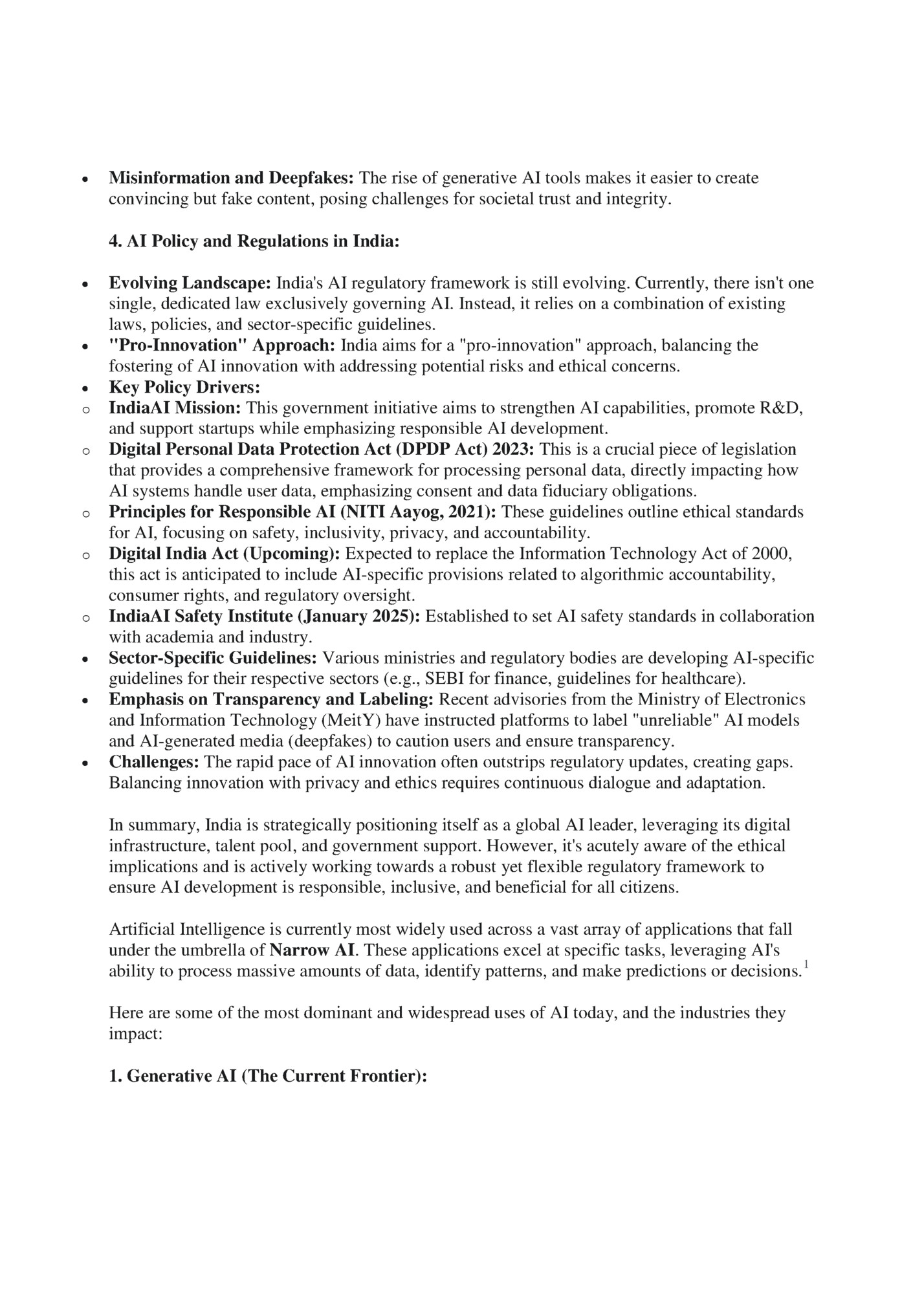
o o o o o What it is: AI that can create new content, such as text, images, audio, video, and even code, often based on a prompt.2 Where it's used: Content Creation: Writing articles, marketing copy, social media posts, scripts, and even entire books.3 Design & Art: Generating images, logos, illustrations, and 3D models.4 Software Development: Assisting with code generation, debugging, and testing.5 Personalization: Creating highly customized marketing materials and user experiences.6 Education: Generating learning materials, summaries, and personalized exercises.7 Examples: ChatGPT, Midjourney, DALL-E, Stable Diffusion, Google's Gemini.8 2. Natural Language Processing (NLP): o o o o o What it is: AI that enables computers to understand, interpret, and generate human language.9 Where it's used: Virtual Assistants & Chatbots: Siri, Alexa, Google Assistant, customer service chatbots on websites.10 Machine Translation: Google Translate, other language translation tools.11 Spam Filters: Identifying and filtering unwanted emails.12 Sentiment Analysis: Analyzing text to understand emotions and opinions (e.g., in customer reviews, social media).13 Text Summarization: Automatically generating concise summaries of longer texts.14 Examples: Voice assistants, customer support automation, search engines (understanding queries).15 3. Computer Vision: o o o o What it is: AI that allows computers to "see," interpret, and understand visual information from images and videos.16 Where it's used: Facial Recognition: Unlocking smartphones, security systems, identity verification.17 Object Detection: Identifying objects in images or real-time video (e.g., in self-driving cars, security cameras).18 Image & Video Analysis: Content moderation on social media, medical image analysis (X-rays, MRIs), quality control in manufacturing.19 Augmented Reality (AR): Enhancing real-world views with digital information. Examples: Self-driving cars, security cameras, medical imaging, social media photo tagging. 4. Recommendation Systems: o o o What it is: AI algorithms that predict user preferences and suggest relevant products, content, or services.20 Where it's used: E-commerce: Product recommendations on Amazon, Flipkart.21 Streaming Services: Movie and show suggestions on Netflix, YouTube, Spotify.22 Social Media: Curated news feeds and friend suggestions on Facebook, Instagram, TikTok.23

Examples: "Customers who bought this also bought...", personalized playlists.24 5. Predictive Analytics & Fraud Detection: o o o o What it is: AI that analyzes historical data to predict future outcomes or identify anomalies. Where it's used: Finance: Detecting fraudulent transactions, credit scoring, algorithmic trading, risk assessment.25 Healthcare: Predicting disease outbreaks, identifying patients at risk of certain conditions, optimizing treatment plans.26 Manufacturing: Predictive maintenance (forecasting equipment failures).27 Retail: Demand forecasting, inventory management.28 Examples: Banking fraud alerts, personalized insurance premiums.29 6. Automation & Robotics: o o o o What it is: AI enabling machines to perform tasks autonomously, often in physical environments. Where it's used: Manufacturing: Assembly line robots, quality control inspections.30 Warehousing & Logistics: Automated guided vehicles (AGVs), robotic sorting.31 Healthcare: Robotic-assisted surgery, automated lab analysis.32 Customer Service: Robotic Process Automation (RPA) for repetitive back-office tasks.33 Examples: Factory robots, robot vacuum cleaners.34 7. Personalization in Digital Experiences: o o o What it is: Tailoring digital content, services, and interactions to individual users based on their data. Where it's used: Online Advertising: Showing targeted ads based on Browse history and demographics. Web Search: Personalized search results based on past queries and location.35 E-commerce & Content Platforms: As mentioned in recommendation systems.36 Examples: Targeted ads on websites, customized news feeds. In essence, AI is most used in applications where there's a need to process vast amounts of data, automate repetitive tasks, personalize experiences, or make quick, data-driven predictions.37 This has led to its widespread adoption across virtually every industry, from tech giants to small businesses.
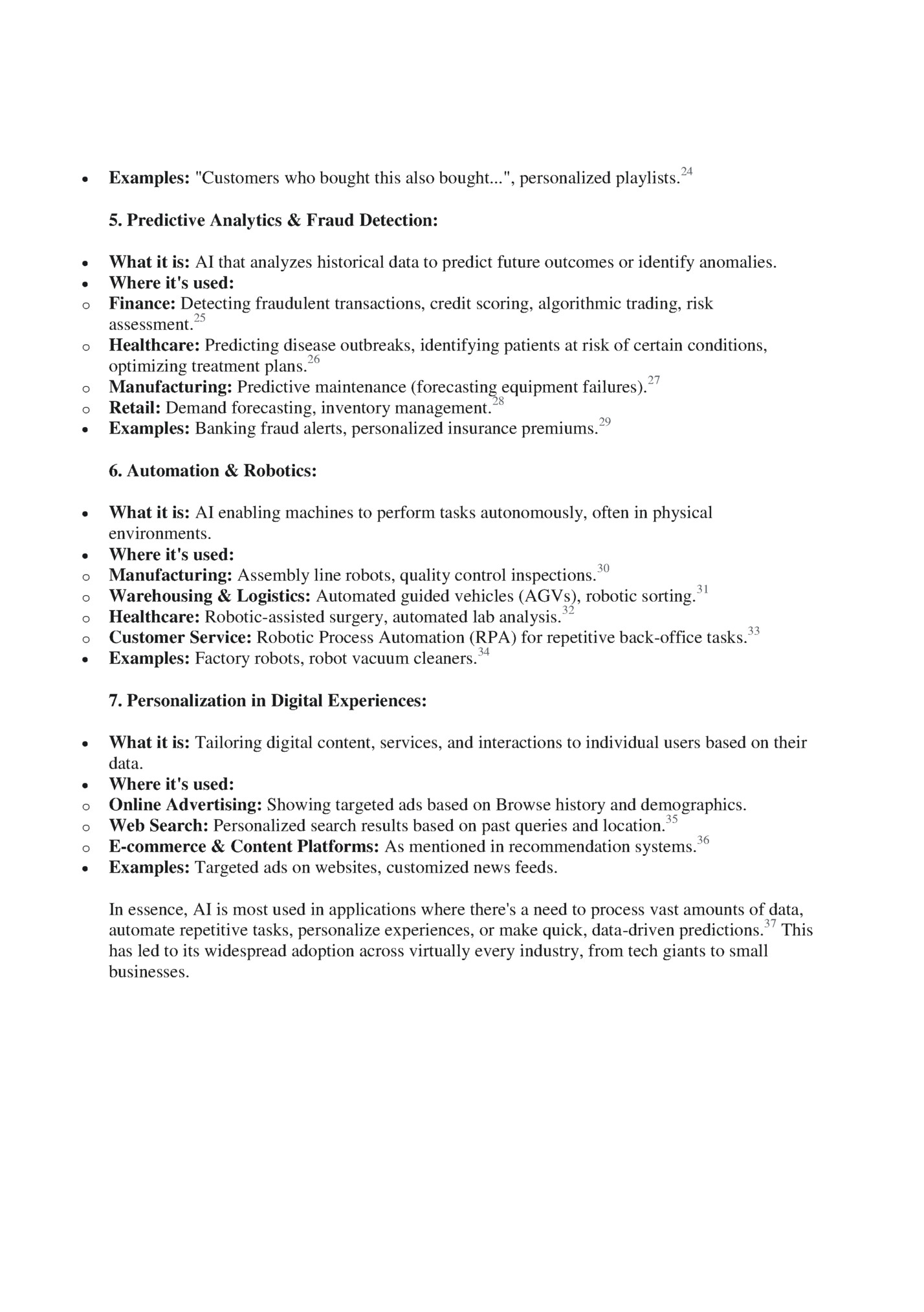
Fleepit Digital © 2021